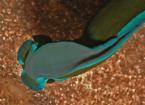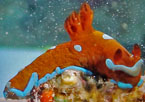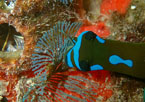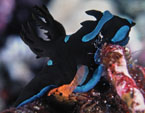| Home |
| Acknowledgments |
| Conventions |
| Glossary |
| Maps |
| References |
| Links |
| Articles |
| Thumbnails |
| Species
list |
| Family |
| Next
species |
Additional Photos

underside

head detail

banded

blue-green gills

light background

blue background

young, 10 mm

feeding

excreting

mating

with eggs

punctured?

survivors _______________
GALLERY

Tambja morosa (Bergh, 1877)

| Maximum size: 121 mm. Identification: This distinctive animal usually has a dark greenish-black body decorated with bright blue-green spots and bands. Rarely, the background may be golden-brown or blue while, in recent years, the branchia have often been decorated with blue-green highlights. (Note 1) Like most Tambja spp, it has almond-shaped, retractile sensory organs below its rhinophores. (see photos) Natural history: Tambja morosa is a common dorid in moderately exposed to highly exposed rocky habitats, particularly shaded cliffs. Rarely, it may be found in Halimeda kanaloana beds. It occurs from about 3-36 m (10-120 ft). It lays an orange egg mass and feeds on a blue bryozoan. (Note 2) Distribution: Big Island, Maui, Lanai, Oahu and Kauai: widely distributed in the Indo-Pacific. Taxonomic notes: It was first recorded in Hawaii at Puako, Big Island by Scott Johnson on May 19, 1978. It is referred to as the "gloomy nudibranch" in Hoover, 1998 & 2006. Photo: John Hoover: Magic Island, Oahu; Oct., 1997. Observations and comments: Note 1: Animals with blue-green highlights on their branchia are common in the western Pacific. However, the pattern was first reported in Hawaii in spring, 2013. Subsequently, it rapidly increased and, by the fall of 2014, the majority of animals found in Maui waters were that form. Since 2016, animals without blue-green highlights have become rare. Perhaps, this is due to a recent introduction of larvae from the western Pacific (either natural or by humans)? Or, perhaps the change is the result of a "genetic switch" that's dependent on temperature or some other environmental factor? Note 2: At the sites we frequent, this species was fairly common in the late 1980s. Then, it became difficult to find for about 20 years. From 2011 to 2013, however, it became increasingly common and has remained so through 2019. That makes it a good example of long term population swings in nudibranchs. Our subjective impression is that the population increase is associated with a substantial increase in its food bryozoan. |
| Thumbnails |
Species
list |
Family | Next species | Top |